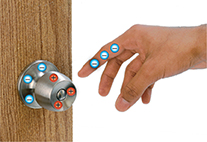Charging by Induction
Suppose you reach for a doorknob after walking across a carpet. You have picked up extra electrons from the carpet, so your hand is negatively charged. The net negative charge in your hand repels electrons in the metal doorknob. Figure 6 shows that electrons move to the base of the doorknob, leaving a net positive charge in the part of the doorknob closest to the hand. Overall, the doorknob is still neutral, but charge has moved within it. This is induction, a transfer of charge without contact between materials.
Static Discharge
Why do you get a shock from a doorknob? The spark you feel is a static discharge.  Static discharge occurs when a pathway through which charges can move forms suddenly. Charges will not travel through air from your hand to the doorknob. But air becomes charged suddenly when the gap between your finger and the doorknob is small. This air provides a path for electrons to flow from your hand to the doorknob. If the room is dark, you can even see this spark.
Static discharge occurs when a pathway through which charges can move forms suddenly. Charges will not travel through air from your hand to the doorknob. But air becomes charged suddenly when the gap between your finger and the doorknob is small. This air provides a path for electrons to flow from your hand to the doorknob. If the room is dark, you can even see this spark.
Lightning is a more dramatic discharge. Charge can build up in a storm cloud from friction between moving air masses. Negative charge in the lower part of the cloud induces a positive charge in the ground below the cloud. As the amount of charge in the cloud increases, the force of attraction between charges in the cloud and charges in the ground increases. Eventually the air becomes charged, forming a pathway for electrons to travel from the cloud to the ground.
Figure 6 Induction occurs when charge is transferred without contact between materials. Negative charges in the hand induce charges to move within the metal doorknob.
Predicting What would happen if the hand had a net positive charge?
 d
dSection 20.1 Assessment
Reviewing Concepts
 How is a net electric charge produced?
How is a net electric charge produced? What determines whether charges attract or repel?
What determines whether charges attract or repel? Name two factors that affect the strength of an electric field.
Name two factors that affect the strength of an electric field. List three methods of charge transfer.
List three methods of charge transfer. Explain how static discharge occurs.
Explain how static discharge occurs.How does electric force depend on the amount of charge and the distance between charges?
What is the law of conservation of charge?
Critical Thinking
Forming Hypotheses Why does plastic food wrap cling better to some materials than to others?
Inferring When a glass rod is rubbed with neutral silk, the glass becomes positively charged. What charge does the silk now have? Explain.
Relating Cause and Effect Many lightning strikes occur within a cloud, rather than between clouds and the ground. Explain why. (Hint: Assume a cloud has no net charge.)
Writing in Science
Explanatory Paragraph Write a paragraph explaining the series of events that may cause you to receive a shock from a metal doorknob on a dry winter day. (Hint: Use a flowchart to organize your ideas before writing your paragraph.)





